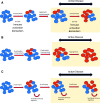Uncovering Pathways to Personalized Therapies in Type 1 Diabetes
- PMID: 33741606
- PMCID: PMC7980192
- DOI: 10.2337/db20-1185
Uncovering Pathways to Personalized Therapies in Type 1 Diabetes
Abstract
The goal of personalized medicine is to match the right drugs to the right patients at the right time. Personalized medicine has been most successful in cases where there is a clear genetic linkage between a disease and a therapy. This is not the case with type 1 diabetes (T1D), a genetically complex immune-mediated disease of β-cell destruction. Researchers over decades have traced the natural history of disease sufficiently to use autoantibodies as predictive biomarkers for disease risk and to conduct successful clinical trials of disease-modifying therapy. Recent studies, however, have highlighted heterogeneity associated with progression, with nonuniform rate of insulin loss and distinct features of the peri-diagnostic period. Likewise, there is heterogeneity in immune profiles and outcomes in response to therapy. Unexpectedly, from these studies demonstrating perplexing complexity in progression and response to therapy, new biomarker-based principles are emerging for how to achieve personalized therapies for T1D. These include therapy timed to periods of disease activity, use of patient stratification biomarkers to align therapeutic target with disease endotype, pharmacodynamic biomarkers to achieve personalized dosing and appropriate combination therapies, and efficacy biomarkers for "treat-to-target" strategies. These principles provide a template for application of personalized medicine to complex diseases.
© 2021 by the American Diabetes Association.
Figures






Similar articles
-
Immune Checkpoint Molecules, Personalized Immunotherapy, and Autoimmune Diabetes.Trends Mol Med. 2018 Nov;24(11):931-941. doi: 10.1016/j.molmed.2018.08.005. Epub 2018 Sep 17. Trends Mol Med. 2018. PMID: 30236470 Review.
-
Integrating Omics into Functional Biomarkers of Type 1 Diabetes.Cold Spring Harb Perspect Med. 2024 Jul 1;14(7):a041602. doi: 10.1101/cshperspect.a041602. Cold Spring Harb Perspect Med. 2024. PMID: 38772709 Review.
-
Immunological biomarkers for the development and progression of type 1 diabetes.Diabetologia. 2018 Nov;61(11):2252-2258. doi: 10.1007/s00125-018-4726-8. Epub 2018 Sep 12. Diabetologia. 2018. PMID: 30209538 Review.
-
Biomarkers in type 1 diabetes: application to the clinical trial setting.Curr Opin Endocrinol Diabetes Obes. 2014 Aug;21(4):287-92. doi: 10.1097/MED.0000000000000076. Curr Opin Endocrinol Diabetes Obes. 2014. PMID: 24937037 Free PMC article. Review.
-
Standardizing T-Cell Biomarkers in Type 1 Diabetes: Challenges and Recent Advances.Diabetes. 2019 Jul;68(7):1366-1379. doi: 10.2337/db19-0119. Diabetes. 2019. PMID: 31221801 Free PMC article.
Cited by
-
From Pancreatic β-Cell Gene Networks to Novel Therapies for Type 1 Diabetes.Diabetes. 2021 Sep;70(9):1915-1925. doi: 10.2337/dbi20-0046. Epub 2021 Aug 20. Diabetes. 2021. PMID: 34417266 Free PMC article. Review.
-
Innovative Designs and Logistical Considerations for Expedited Clinical Development of Combination Disease-Modifying Treatments for Type 1 Diabetes.Diabetes Care. 2022 Oct 1;45(10):2189-2201. doi: 10.2337/dc22-0308. Diabetes Care. 2022. PMID: 36150059 Free PMC article. Review.
-
Evaluation of teplizumab's efficacy and safety in treatment of type 1 diabetes mellitus: A systematic review and meta-analysis.World J Diabetes. 2024 Jul 15;15(7):1615-1626. doi: 10.4239/wjd.v15.i7.1615. World J Diabetes. 2024. PMID: 39099823 Free PMC article.
-
The heterogeneity of type 1 diabetes: implications for pathogenesis, prevention, and treatment-2024 Diabetes, Diabetes Care, and Diabetologia Expert Forum.Diabetologia. 2025 Sep;68(9):1859-1878. doi: 10.1007/s00125-025-06462-y. Epub 2025 Jul 30. Diabetologia. 2025. PMID: 40736750 Free PMC article. Review.
-
Glycemic Variability Patterns Strongly Correlate With Partial Remission Status in Children With Newly Diagnosed Type 1 Diabetes.Diabetes Care. 2022 Oct 1;45(10):2360-2368. doi: 10.2337/dc21-2543. Diabetes Care. 2022. PMID: 35994729 Free PMC article.
References
Publication types
MeSH terms
Substances
Grants and funding
LinkOut - more resources
Full Text Sources
Other Literature Sources
Medical

